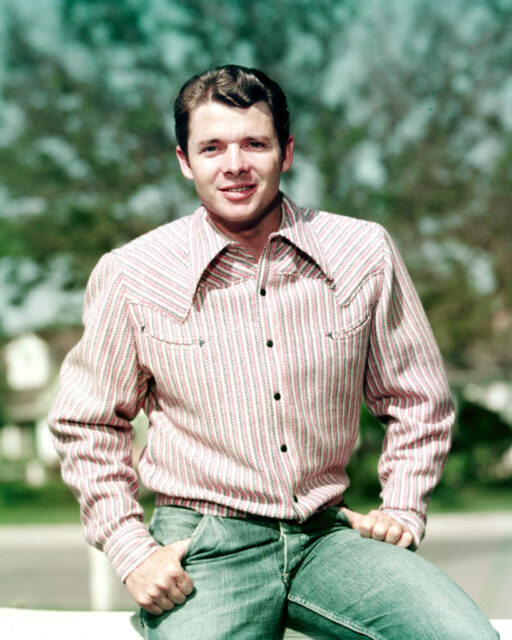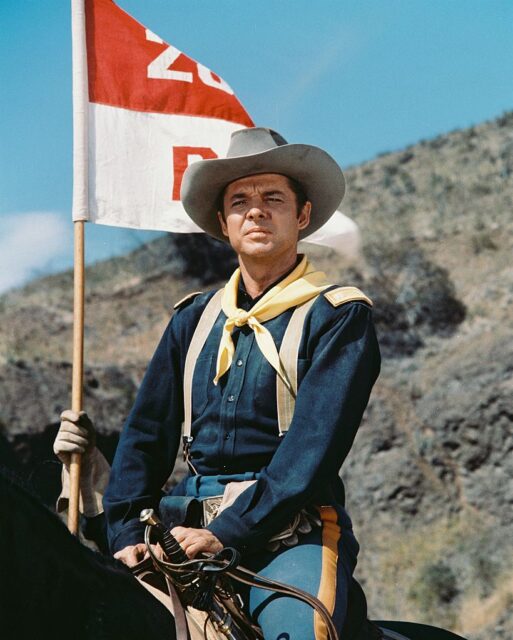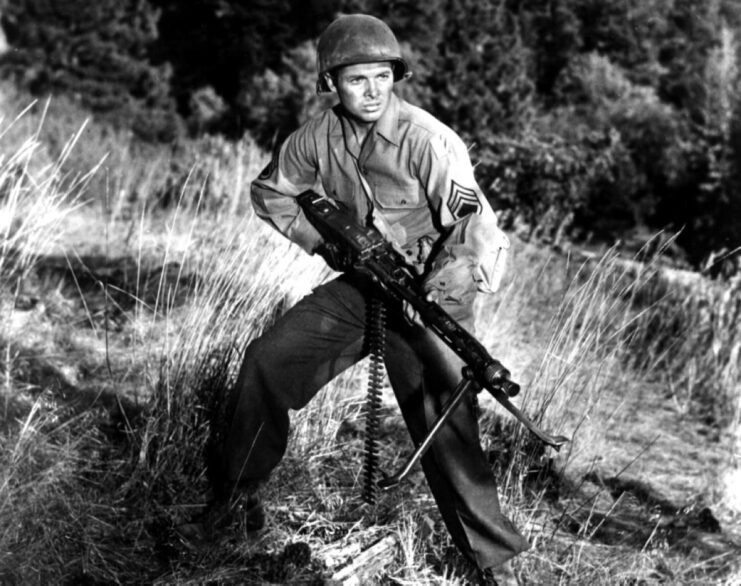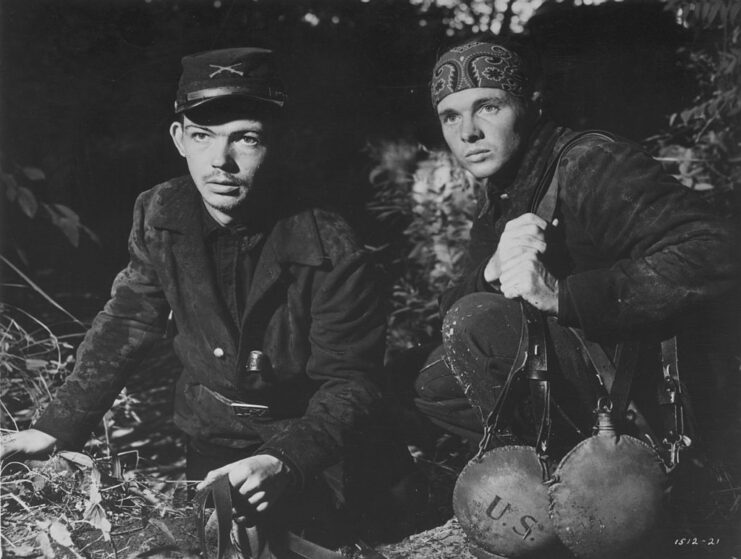Audie Murphy gained widespread recognition for his extraordinary bravery during World War II, ultimately becoming the most decorated American soldier in history. After his military service, he transitioned into acting, establishing a successful film career and famously starring in a movie that depicted his own extraordinary wartime experiences.
Here are nine intriguing and lesser-known facts about this exceptional actor and war hero.
He was rejected from the US Navy and Marine Corps

After the Japanese attack on Pearl Harbor, Audie Murphy was set on joining the US military. Although he faced several obstacles in his early attempts to enlist in the Marine Corps, Navy, and Army due to his age and being underweight, Murphy never gave up.
Murphy got his sister’s help to adjust his documents, making himself appear older than he truly was. With this altered information, he made another attempt to join the US Army and eventually succeeded.
He began his military career at Camp Wolters, Texas, where he completed basic training and earned several prestigious awards, including the Expert Badge with Bayonet Component Bar and the Marksman Badge with Rifle Component Bar. He then proceeded to Fort Meade, Maryland, for advanced infantry training.
Audie Murphy single-handedly held off a company of German troops

In February 1943, Audie Murphy was deployed to the Mediterranean, where he engaged in action before being transferred to the European Theater – the setting of most of his wartime service. One particularly noteworthy incident during this period led to his receipt of the Medal of Honor.
By January 1945, Murphy was stationed in the Colmar Pocket with his platoon. Later relocated to Holtzwihr with the 3rd Infantry Division, they faced a German counterattack. Despite sustaining injuries, Murphy assumed command of Company B, prioritizing the safety of his men over his own well-being.
When the Germans ignited an M10 tank destroyer, Murphy directed his soldiers to retreat to the woods, away from enemy fire. Armed only with his M1 Carbine and a radio for artillery coordination, he climbed onto the armored vehicle and manned its .50-caliber machine gun, firing at the advancing troops for an hour and inflicting 50 casualties.
During this courageous act, Murphy sustained another injury to one of his legs. Undeterred by his wounds, he returned to his men and led a full-man charge against the German forces. Speaking about Murphy’s bravery, Pvt. Charles Owen recalled, “He saved our lives. If he hadn’t done what he did, the Germans would have annihilated us.”
The US Army changed how he viewed his name

During his younger years, Audie Murphy harbored a dislike for his first name. As a result, he often chose to use his middle name, Leon. His older sister had given him this name, not knowing its Latin meaning, “lion.” Interestingly, the name turned out to be appropriate, given Murphy’s extraordinary accomplishments during World War II.
It was when he joined the US Army that Murphy began to appreciate his first name. In the military, “Leon” was seen as a name from the countryside, so he started using the nicknames “Audie” or “Murph” for the rest of his life.
Awarded every US military combat award for valor – and then some

Audie Murphy holds the distinction of being the most decorated soldier in American history, a title that goes beyond symbolism – he genuinely earned each of the ones bestowed upon him.
Murphy was presented the Medal of Honor, the Distinguished Service Cross, the Silver Star with bronze oak leaf cluster, the Legion of Merit, the Bronze Star with “V” Device, the Purple Heart with two bronze oak leaf clusters, the Presidential Unit Citation with First Oak Leaf Cluster, the Army Outstanding Civilian Service Medal and the Texas Legislative Medal of Honor.
In addition, he received several campaign medals, including the Good Conduct Medal, the American Campaign Medal, the European-African-Middle Eastern Campaign Medal, the World War II Victory Medal, the Army of Occupation Medal with Germany Clasp and the Armed Forces Reserve Medal. Murphy also earned various badges, such as the Combat Infantryman Badge, the Marksman Badge with Rifle Component Bar and the Expert Badge with Bayonet Component Bar.
Remarkably, these are only the awards presented to him by the US military!
Murphy’s recognition extended beyond national borders, as he also received honors from both the French and Belgians. These international honors encompassed the French Legion of Honor – Grade of Chevalier (Knight), the French Croix de Guerre with Silver Star, the French Croix de Guerre with Palm, the Medal of a Liberated France, the Belgian Croix de Guerre with 1940 Palm and the French Fourragère in Colors of the Croix de Guerre.
Audie Murphy suffered from battle fatigue for the rest of his life

Audie Murphy, previously diagnosed with “battle fatigue,” experienced post-traumatic stress disorder (PTSD) following his service in World War II. Upon returning home, he grappled with insomnia and depression, prompting him to seek professional help.
A physician prescribed Placidyl, a powerful sedative, which inadvertently led to addiction. Recognizing the grip of the drug, he embarked on a solitary detoxification process, isolating himself in a motel room without medication for a week.
Unlike many of his peers, Murphy took on the role of a mental health advocate, particularly for returning veterans from Korea and Vietnam. He openly discussed his own challenges, urging the US government to increase research into the psychological impact of combat.
He wanted to make a movie about Desmond Doss’ military service

There was a time when Audie Murphy wanted to create a film about fellow Medal of Honor recipient Desmond Doss. Doss had earned the prestigious decoration for his heroic actions at Hacksaw Ridge during the Battle of Okinawa, risking his life to treat wounded comrades, even under relentless enemy fire. He ended up saving 75 men.
Hal B. Wallis, producer of Casablanca (1942), enlisted Murphy to persuade Doss to sell his story to Hollywood. However, he did not see himself as a hero and refused the offer, fearing his character might be misrepresented or compromised. It wasn’t until the release of Hacksaw Ridge in 2016 that Doss’s extraordinary bravery was finally brought to the big screen.
Audie Murphy portrayed himself in To Hell and Back (1955)

It’s quite unusual for someone to have a film made about their own life, and even rarer for them to play themselves in it. Audie Murphy is among the few who achieved this, starring as himself in the 1955 film To Hell and Back, which was adapted from the 1949 autobiography written by his friend, David McClure.
To Hell and Back depicts Murphy’s experiences during World War II and features actors such as Jack Kelly, Marshall Thompson, Charles Drake, Gregg Palmer, and Paul Picerni, along with several other notable figures. The film premiered on the anniversary of his discharge from the US Army and garnered mostly positive reviews.
Despite being poor, there were still products he wouldn’t promote

During the twilight years of his life, Audie Murphy faced financial challenges. He suffered substantial losses, amounting to several hundred thousand dollars, in an Algerian oil venture, and the Internal Revenue Service (IRS) pursued him for outstanding tax debts.
While many actors would have readily embraced any job opportunity that came their way, Murphy remained steadfast in upholding his principles. Despite being presented with numerous offers for cigarette and alcohol advertisements, he declined each one, as he was resolute in his commitment to setting a positive example for his youthful admirers.
Audie Murphy is buried at Arlington National Cemetery

On May 28, 1971, Audie Murphy lost his life when his private plane crashed into the side of a mountain in Roanoke, Virginia, while en route to a business engagement. On June 7, in recognition of his military service, he was laid to rest with full military honors at Arlington National Cemetery.
New! Want to become a trivia master? Sign up for our War History Fact of the Day newsletter!
More from us: Henry Fonda Served In the US Navy During WWII – He Didn’t Want to ‘Be a Fake In a War Studio’
Given his status as both a famous actor and a decorated soldier, Murphy’s gravestone fast became a high-traffic area, becoming the second-most visited at Arlington, after that of President John F. Kennedy. The amount of visitors prompted the construction of a flagstone walkway, and those wishing to visit the gravesite can find it in Section 46, across from the Memorial Amphitheater.
